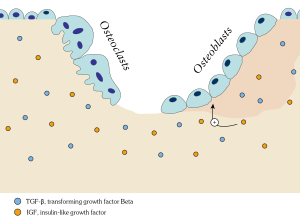Bone Homeostasis and Cellular Interactions
- Bone homeostasis involves multiple coordinated cellular and molecular events.
- Osteoblasts secrete new bone, while osteoclasts break down bone.
- Close cooperation between osteoblasts, osteoclasts, and other cell populations is required for bone structure and calcium supply.
- Bone metabolism relies on signaling pathways and control mechanisms involving hormones, cytokines, and growth factors.
Bone Remodeling Process
- Bone remodeling is an active, continual process that maintains proper calcium levels.
- Osteoblasts actively synthesize osteoid containing two osteocytes.
- Osteoclasts have multiple nuclei and a foamy cytosol.
- Illustration showing the bone remodeling cycle.
Related Concepts
- Biomineralization, the process of forming and maintaining mineralised tissues.
- Tissue remodeling.
- Wolff's law, which states that bone adapts to the loads placed upon it.
References
- Wheeless Textbook.
- Online Medical Dictionary.
- Raggatt, L. J. et al. (2010). Cellular and Molecular Mechanisms of Bone Remodeling. The Journal of Biological Chemistry, 285(33), 25103–25108.
- Sims, N. A. et al. (2014). Coupling the activities of bone formation and resorption: a multitude of signals within the basic multicellular unit. BoneKey Reports, 3, 481.
- Shirazi, S., Ravindran, S., & Cooper, L. F. (2022). Topography-mediated immunomodulation in osseointegration; Ally or Enemy. Biomaterials, 291, 121903.
Note
- The last bullet point is incomplete as there are not enough references provided.
In osteology, bone remodeling or bone metabolism is a lifelong process where mature bone tissue is removed from the skeleton (a process called bone resorption) and new bone tissue is formed (a process called ossification or new bone formation). These processes also control the reshaping or replacement of bone following injuries like fractures but also micro-damage, which occurs during normal activity. Remodeling responds also to functional demands of the mechanical loading.

In the first year of life, almost 100% of the skeleton is replaced. In adults, remodeling proceeds at about 10% per year.
An imbalance in the regulation of bone remodeling's two sub-processes, bone resorption and bone formation, results in many metabolic bone diseases, such as osteoporosis.